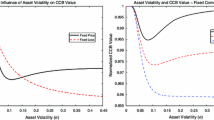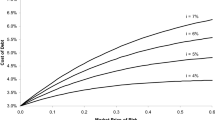Abstract
This article extends previous bond valuation models to account for more realistic assumptions regarding financial distress. Realized value of an individual bond under severe financial distress will reflect the expected outcome of credit-event negotiations and the relative priority listing of the security. We explicitly represent the probability rate of credit-event occurrence as a function of firm value relative to the fixed overall debt obligations of the firm. Risk premiums generated under reasonable parameter value choices fall within the range of observed bond risk premiums. Our model also provides an explanation as to why observed bond risk premia are positive after adjustment for default.
Similar content being viewed by others
References
Altman, E., “Financial Ratios, Discriminant Analysis and the Prediction of Corporate Bankruptcy.” Journal of Finance 23, 589–609 (September 1968).
Altman, E., “A Further Investigation of the Bankruptcy Cost Question.” Journal of Finance 44, 909–922, (September 1989).
Asquith, P., D.W.Mullins Jr., and E.D.Wolff, “Original Issue High Yield Bonds: Aging Analysis of Defaults, Exchanges and Calls.” Journal of Finance 44, 923–952, (September 1989).
Black, F. and J.C.Cox, “Valuing Corporate Securities: Some Effects of Bond Indenture Provisions.” Journal of Finance 31, 351–567, (May 1976).
Boyle, P.P., “Options: A Monte Carlo Approach.” Journal of Financial Economics 4, 323–338, (1977).
Brown, D.T., C.M. James, and R.M. Mooradian, “The Informational Content of Exchange Offers Made by Distressed Firms.” Working paper, University of Florida, 1990.
Constantinides, G.M., “Market Risk Adjustments in Project Valuation.” Journal of Finance 33, 603–616, (May 1978).
Eberhart, A.C., W.T.Moore, and R.L.Roenfeldt, “Security Pricing and Deviations from the Absolute Priority Rule in Bankruptcy Proceedings.” Journal of Finance 45, 1457–1469, (December 1990).
Eberhart, A.C. and R.J.Sweeney, “Does the Market Predict Bankruptcy Settlements?” Journal of Finance 47, 943–980, (July 1992).
Fischer, E.O., R.Heinkel, and J.Zechner, “Dynamic Capital Sturcture Choice: Theory and Tests.” Journal of Finance 44, 19–40, (March 1989).
Franks, J.R. and W.N.Torous, “An Empirical Investigation of U.S. Firms in Reorganization.” Journal of Finance 44, 747–769, (July 1989).
Franks, J.R. and W.N.Torous, “A Comparison of Financial Recontracting in Distressed Exchanges and Chapter 11 Reorganizations.” Journal of Financial Economics 35, 349–370, (June 1994).
Giammarino, R.M., “The Resolution of Financial Distress.” Review of Financial Studies 2, 25–47, (1989).
Ho, T.S. and D.F.Singer, “Bond Indenture Provisions and the Risk of Corporate Debt.” Journal of Financial Economics 10, 375–406, (December 1982).
Ho, T.S. and D.F.Singer, “The Value of Corporate Debt with a Sinking Fund Provision.” Journal of Business 57, 315–336, (July 1984).
Kim, I.J., K.Ramaswamy, and S.Sundaresan, “Does Default Risk in Coupons Affect the Valuation of Corporate Bonds? A Contingent Claims Model.” Financial Management 22, 117–131, (Autumn 1993).
LoPucki, L.M. and W.C. Whitford, “Bargaining Over Equity's Share in Reorganization of Large Publicly Held Companies.” University of Pennsylvania Law Review, 125–196, (1990).
Mauer, D.C. and A.J.Triantis, “Interactions of Corporate Financing and Investment Decisions: A Dynamic Framework.” Journal of Finance 49, 1253–1277, (September 1994).
Merton, R.C., “On the Pricing of Corporate Debt: The Risk Structure of Interest Rates.” Journal of Finance 29, 449–470, (May 1974).
Merton, R.C., Continuous Time Finance. Cambridge, MA: Basil Blackwell, 1990.
Riddiough, T.J. and H.E.Thompson, “Commerical Mortgage Pricing with Unobserable Borrower Default Costs,” Journal of the American Real Estate and Urban Economics Association 21, 265–291, (Fall 1993).
Schwartz, E.S. and W.N.Torous, “Prepayment and the Valuation of Mortgage-Backed Securities.” Journal of Finance 44, 375–392, (June 1989).
Shimko, D.C., “The Equilibrium Valuation of Risky Discrete Cash Flows in Continuous Time.” Journal of Finance 44, 1373–1384 (December 1989).
Shulman, J., M.Bayless, and K.Price, “Marketability and Default Influences on the Yield Premia of Speculative-Grade Debt.” Financial Management 22, 132–141, (Autumn 1993).
Stein, B.J., A License to Steal, New York, NY: Simon and Schuster, 1992.
Stulz, R.M. and H.Johnson, “An Analysis of Secured Debt.” Journal of Financial Economics 14, 501–521, (December 1985).
Warner, J.B., “Bankruptcy Costs: Some Evidence”. Journal of Finance 32, 337–448, (May 1977).
Author information
Authors and Affiliations
Rights and permissions
About this article
Cite this article
Riddiough, T.J., Thompson, H.E. Valuing Debt in a Complex Capital Structure. Rev Quant Finan Acc 6, 203–221 (1996). https://doi.org/10.1007/BF00245180
Issue Date:
DOI: https://doi.org/10.1007/BF00245180




